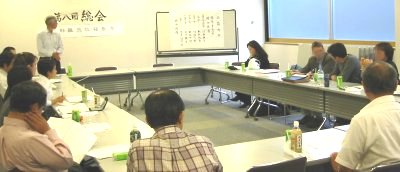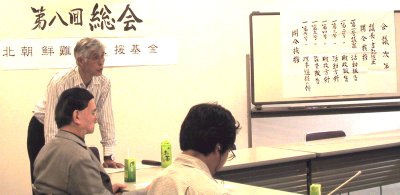
|
|
LFNKR Report
for Fiscal Year 2005
Sept. 2004 to
Aug. 2005
On Oct. 9, 2005, LFNKR held its annual General Meeting
in Tokyo.
 Kato
Hiroshi addresses members at LFNKR General Meeting
Kato
Hiroshi addresses members at LFNKR General Meeting |
 The
group gets down to business
The
group gets down to business |
This report outlines the achievements of LFNKR during the last
fiscal year
| I. |
Efforts
to rescue North Korean defectors and detained humanitarian
aid workers
LFNKR
has expanded its collaboration with NGOs and aid workers
in China, South Korea, Laos,
Thailand, Burma, the USA, England,
France, Germany, and Belgium. Last year, LFNKR stepped up its efforts to develop new
routes via which North Korean refugees may escape to
third countries, and it secured more “underground
railroad” routes in addition to those already established.
In a concerted effort to press the Chinese government
to improve its policy toward North Korean refugees, several
NGOs now working to rescue North Korean refugees have
begun strongly urging that the 2008 Olympics be transferred
away from Beijing as the host city. This campaign must
be expanded. It is currently underway only in the US,
South Korea, and Japan, but should be expanded to many
other nations around the world.
|
| |
A. |
Efforts to gain the release of humanitarian
aid workers detained in China
LFNKR continues its activities to achieve the release
of humanitarian aid workers arrested and detained in
China,
primarily through lobbying activities and collaboration
with other NGOs. The aid workers include Choi Yong-hun,
who was
sentenced to 5 years in prison for attempting to help
North Korean refugees out of China by boat in Yantai
(imprisoned
since January 2003), An Chung-hak (detained in Yanji,
China since February 2005), and Phillip J. Buck (detained
in Yanji,
China since May 2005). All were arrested for helping
North Korean refugees.
— Choi
Yong-hun link (Read
more here)
— An Chung-hak link (Read
more here)
— Phillip J. Buck (Read
more here)
|
| |
B. |
Securing the safety and protection of North
Korean refugees
|
| |
|
1. |
Securing necessary shelters
During the last fiscal year, LFNKR avoided adding large
shelters, due to safety considerations. Instead, shelters
were smaller
and more widely dispersed.
|
| |
|
2. |
Supply
of clothing
LFNKR
supplied a total of 500 sets of winter clothing and 450
sets of summer clothing.
|
| |
|
3. |
Supply of food
Through
its clandestine local network, LFNKR supplied a total
of 40 tons of rice to the North Koreans hiding
in China
as well as to some needy people in North Korea. One
major distribution network in North Korea was discovered
by the
authorities, leading to a severe 20-ton curtailment
of rice distribution
|
| |
|
4. |
Other
LFNKR
has directly provided money equivalent to a few month’s
living expenses to a total of 11 families. This money was
secretly taken back into North Korea where 28 near-starving
family members waited.
|
| II. |
Medical
aid
Medical
expenses were paid to cover hospitalization and treatment
of North Koreans suffering from carbon monoxide
poisoning,
hepatitis, and injuries resulting from torture.
|
| III. |
Foster
Parent Program
The
Chinese government continues to intensify efforts to arrest
and repatriate North Koreans. At the same time,
it is systematically arresting and indicting humanitarian
aid workers. This has seriously interfered with LFNKR
foster parents’ visits to China to meet with their
foster children. LFNKR has, however, worked out a number
of ways
to maintain communication with the local staff members
to assure the flow of updated information on the situations
of all its foster children. Currently, 35 North Korean
children are in the foster parent program.
From
November 8 to 10, 2004, the North Korean Genocide Exhibition
was held at the Diet Members’ Hall in
Seoul. Twelve members of LFNKR, including several foster
parents, visited Seoul to participate in the event. While
there, they met with some of their former foster children,
who had previously stayed at Shelter YAN-01 in China and
had reached South Korea only the previous year. A TV crew
videotaped the meeting with the former foster children.
The footage was entitled, “After Burying My Parents,
Who Starved to Death.” LFNKR has sent the videotape
to every foster parent in Japan.
Last
year’s annual report on the 7th General Meeting
stated that one major objective would be to bring those
foster children aged 16 or older out of China. Once past
16, they find it extremely difficult to remain in China
because the authorities are increasingly strict about the
legal documents required for admission to higher education.
In the spring of 2005, LFNKR brought the most recent foster
child out of China to a safe place, where he will now be
able to decide his own future.
In May 2005, LFNKR received an urgent request to help
one of the children it had sheltered in the past, and his
mother. Under the foster parent program, LFNKR immediately
formed a rescue team and helped both mother and son to
successfully reach South Korea. The boy had been seized
at a shelter in China and sent back to North Korea in the
spring of 2001, when he was 15 years old, but had been
able to escape once again into China.
The LFNKR foster parent program provided emergency medical
aid for two of its foster children when they suffered acute
carbon monoxide poisoning from a malfunctioning heater.
Fortunately, they fully recovered with no aftereffects.
LFNKR
invited three former foster children to Japan to participate
in a 3-day joint international conference between
parliamentary members and NGOs held on August 1, 2005.
On July 30, they talked about their own experiences before
and after they escaped from North Korea. The audience was
held breathless as the children told of their hazardous
escape from China. (Read
profiles of the 3 children here)
All members of LFNKR were proud when one of the former
foster children, now settled in South Korea, passed the
entrance examination to the prestigious Sogang University
in South Korea.
|
| IV. |
Helping
North Korean defectors settle in South Korea and Japan
During
the past fiscal year, LFNKR has successfully helped a number
of North Korean refugees, including several former
foster children, to escape from China into South Korea
via third-country routes. LFNKR has been working together
with
the Korean Residents’ Union in Japan to help the
North Korean defectors complete all legal procedures, find
housing
and jobs, and all other necessary details. LFNKR is also
providing them with private tutoring to learn Japanese.
|
| V. |
International
activities
|
| |
A. |
When 29 North Koreans dashed into the Japanese
school in Beijing on Sept. 1 2004 year, and when 8 North
Koreans ran into the American school in Shanghai on Sept.
27, all seeking asylum, LFNKR immediately sent out requests
urging the Japanese and US governments to protect them and
give them safe passage to wherever they wished to settle.
They were allowed to go to South Korea.
In
October, LFNKR sent a request to the Ministry of Canada,
urging them to protect the 44 North Koreans who had sought
asylum in the Canadian Embassy in Beijing. LFNKR received
in March 2005 a letter from the Minister of Foreign Affairs
of Canada stating that his government had persuaded the Chinese
government to safely release them to South Korea.
|
| |
B. |
When
12 LFNKR members went to Seoul in November last year,
they visited more than 60 Grand National Party
lawmakers to seek their support for NK refugees and asked
their help in gaining immediate release of Choi Yong-hun,
now serving a 5-year sentence. This led to the visit of
three Korean lawmakers to the prison in Yantai where
Choi Yong-hun
has been jailed. They protested the inhumane treatment
of Choi to the prison warden, and called for improved
conditions.
(Read
more here)
|
| |
C. |
In
March 2005, LFNKR produced a 13-minute English version
DVD of secretly taped footage showing public executions
in North Korea. This DVD was submitted to the UNCHR meeting
held in Geneva in March. The DVD was recognized as valuable
material demonstrating evidence of human rights violations
in North Korea. The footage was subsequently broadcast
by
major media, including BBC, CNN, and FOX TV. (Read
more here)
|
| |
D. |
Kato
Hiroshi, the Secretary-General of LFNKR, along with two
other members participated in the North
Korea Freedom Week held in Washington DC in April 2005.
During
their stay, they met with Jim Butterworth and agreed on
a joint effort to produce a version of his documentary “Seoul
Train” with Japanese subtitles. The version with
Japanese subtitles was first screened during the Lawmakers-NGO
joint
international conference event. (Read
more here)
|
| VI. |
Seminars
LFNKR presented several seminars, including those attended
by local staff members responsible for the shelters in China
and former foster children. LFNKR also dispatched members
to junior high schools to present lectures on the current
situation faced by North Korean refugees. |
|


